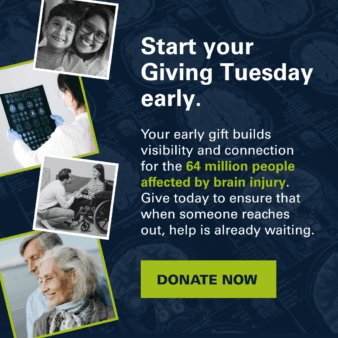Ten Elements of Successful Aging After Brain Injury
Categories: Living with Brain Injury, Research
Aging is not a disease; it starts at birth and continues across various developmental life stages. But environmental and lifestyle factors play a more important role in successful aging than genetic factors. More research is needed to identify the modifiable environmental and lifestyle factors that are unique to long-term survivors of brain injury. This requires a leap beyond the simple biology to a greater understanding of the biopsychosocial model of successful aging.
The following 10 elements, built upon concepts identified by the Alzheimer’s Association, are designed to promote successful aging in persons with brain injury:
Element 1. Exercise
Exercise is a critical lifestyle factor that has multiple benefits, including reducing rates of heart disease, cancer, and stroke. Exercise also improves respiratory fitness and balance53 and can reduce the risks of falls, an identified issue among individuals with a brain injury and a common cause of brain injury in aging populations. Exercise is beneficial to mood, cognition, digestion, skin integrity, reducing osteoporosis, and numerous other health benefits, including prevention of deep vein and pulmonary thrombosis. Formal physical therapy may be part of some individuals’ recovery from brain injury, but exercise should be part of everyone’s daily life.
Element 2. Brain Health
Exercise the brain to stay mentally active. Development of hobbies, work skills, and access to stimulating environments with art, music, and activities provide brain enrichment. Such activities can also provide satisfying interaction opportunities for caregivers and assist in developing relationships.
Element 3. Heart Health
Heart health is vital, as several cardiovascular risk factors are also risk factors for AD. Another cardiovascular disease risk factor is obesity. Recognizing, diagnosing, and intervening for cardiovascular risk factors benefits heart health and reduces the risk of developing Alzheimer’s.
Element 4. Advocate
Form partnerships for TBI advocacy through alliances with communities representing other brain-related conditions, including AD and behavioral health, given the common concerns and needs faced by those with brain-related conditions.
Element 5. Nutrition
Nutrition influences successful aging, which can be a challenge for individuals with TBI who are struggling socioeconomically, reliant on others for meals, or having difficulty managing appetites for unhealthy food. Few people receive formal nutrition education, and often families and direct support professionals may have poor dietary habits. Generally agreed upon nutritional guidelines support minimizing consumption of sugar and highly refined carbohydrates as well as saturated fats and trans-fats typically found in unhealthy foods. Vegetables, fruit, and whole grains should be emphasized for their benefits to overall health and cognitive function. This pattern of consumption is characteristic of Mediterranean-type diets, which are often recommended to improve cardiovascular status. Fatty fish are recommended for their long chain omega-3 fatty acids, although risks for heavy metal pollution and PCBs are a concern, and some individuals prefer to instead utilize nutritional supplements free from potential contaminants.
Element 6. Mental Health
Promote mental health. Depression, anxiety, and other related conditions detract from quality of life and increase the risk for suicide, and poor health habits adversely impact fitness and cognitive factors. Stress hormones further harm the brain due to their potential toxicity in the hippocampus, a region responsible for forming memories. Timely diagnosis and treatment of behavioral health problems is imperative.
Element 7. Protect the Brain
Protect the brain to maintain brain health and to minimize risk of repetitive brain injuries. Use of helmets, seatbelts, and fall risk assessment and prevention programs are obvious targets. In particular, fall prevention is often underappreciated in home- and community-based residential settings for individuals aging with brain injury. However, caring for the brain also includes prior recommendations regarding avoiding misuse and providing adequate and regular sleep cycles.
Element 8. Socialize
Avoid social isolation to maximize opportunities for love and laughter. While neurocognitive elements of brain injury may increase social isolation, other factors may contribute to isolation, including institutionalization, poverty, and lack of transportation.
Element 9. Avoid Drugs and Alcohol
Avoid the use of illicit substances, as well as tobacco and alcohol. Many substances can cause or exacerbate brain injury while also increasing the risk for cancer, cardiovascular disease, and respiratory problems. Alcohol use disorder (AUD) can interfere with recovery and often has serious, even potentially life-threatening, interactions with common anti-seizure and psychiatric medications used post-injury. AUD can cause injury to the brain, up to and including Wernicke’s encephalopathy and Korsakoff syndrome, both profoundly disabling neurologic conditions.
Element 10. The Brain Is Capable of Making Billions of Connections. Make More!
Look for greatness in each person throughout their journey, even far post injury and through periods of slow or negligible apparent progress. Note these four remarkable variables from Brain Facts: A Primer on the Brain and Nervous System:
- The human brain has about as many neurons as there are stars in the Milky Way galaxy (over 100 billion)
- Under normal circumstances, there are 10 times as many cells called glia cells, which play a supportive role in the nervous system and, following injury, can contribute to its secondary complications
- Each neuron makes connections with thousands of other neurons over synapses
- The synaptic connections change each time we do something, experience something, or learn something
Every brain (and therefore every person) is remarkable and unique, always developing and with potential. Regardless of age or time since injury, neuroplasticity continues to foster our brain’s ongoing evolution through to our last breath. Until then, none of us has plateaued.
Note: This is a 2025 update to a 2018 article originally written by Paul F. Aravich, Ph.D., and Anne H. McDonnell, MPA, OTR/L

